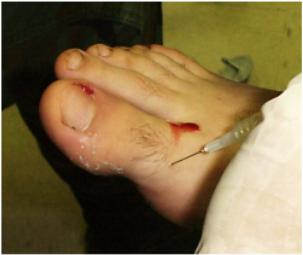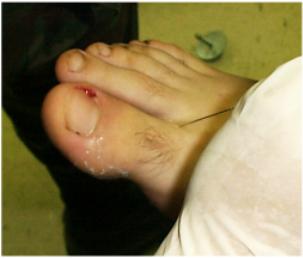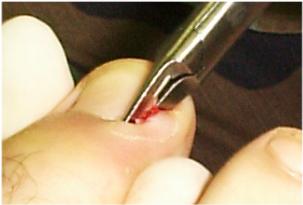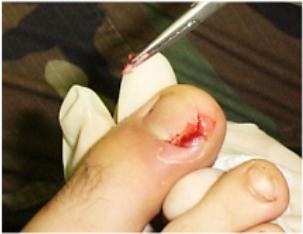Ingrown Toe Nail
Important items to consider in the history:
-
Etiology
-
Improper nail trimming (nails should be cut
straight across)
-
Improper shoe gear (a narrow or tight toe
box)
-
Trauma (resulting in irregular growth)
-
Genetic predisposition (check family
history)
-
Painful nail fold due to incurvated nail
border.
-
Previous occurrence and recurrence after
procedure
- Differential diagnosis:
-
Paronychia - Infection of nail fold due to
irritation without presence of incurving nail.
-
Onychomycosis (fungal nails) - Thickening
of nail due to fungal infection, bacterial infection uncommon.
Physical exam will show:
-
Edema
-
Erythema
-
Warmth of the nail fold, usually the lateral
nail fold.
-
If present for a period of time, localized
infection may produce serosanguanous or purulent drainage.
-
Lymphangitis is uncommon but may be present in
very neglected situations.
-
Granulomatous tissue (proud flesh) may be
present chronic cases.
Treatment:
If unable to perform procedure, use soaks and
antibiotics
Procedure. This
is a clean but not sterile procedure.
-
Set up equipment
-
Scrub the foot
-
Digital block (1% or 2% xylocaine without
epinephrine)
-
Inject the proximal digit on medial and lateral
aspect with 3cc
-
Loosen the skin overlying the nail fold
-
Use thin elevator to free the nail from the
nail bed
-
Use nail cutter (English anvil) to cut the nail
to matrix
-
Use hemostat to remove nail
-
Phenol (89%) application if permanent ablation
of nail matrix (root) is desired in
-
Intractable cases - 2 applications for 30 sec.,
then neutralize with alcohol
-
Place topical antibiotic, dressing
-
Daily dressing changes for 5 days (longer with
phenol procedure)
-
Domeboro or Epsom salts soaks for 1 week
(longer with phenol procedure)

Ingrown toenail with redness, swelling, tenderness and warmth

Inject about 3 cc of 1% xylocaine
without epinephrine
on the medial side of the toe.

Inject another 3 cc of xylocaine
without epinephrine
on the lateral side of the toe.

Use a thin elevator to free the nail from the nail bed.

Us a nail cutter (English Anvil) to cut the nail
down to the nail matrix.

Use a hemostat to lift the cut nail off and out.
|
Christopher
Kardohely, DPM, HM2 (FMF) George Pugh, and Scott D. Flinn, MD
For further information, read:
Operational
Podiatry, in the General Medical Officer Manual
Home
· Military Medicine
· Sick Call · Basic Exams
· Medical Procedures
· Lab and X-ray · The Pharmacy
· The Library · Equipment
· Patient Transport
· Medical Force
Protection · Operational Safety · Operational
Settings · Special
Operations · Humanitarian
Missions · Instructions/Orders · Other Agencies · Video Gallery
· Forms · Web Links · Acknowledgements
· Help · Feedback
Approved for public release;
Distribution is unlimited.
Bureau of Medicine and Surgery
Department of the Navy
2300 E Street NW
Washington, D.C
20372-5300 |
Operational Medicine
Health Care in Military Settings
CAPT Michael John Hughey, MC, USNR
NAVMED P-5139
January 1, 2001 |
United States Special Operations
Command
7701 Tampa Point Blvd.
MacDill AFB, Florida
33621-5323 |
*This web version is provided by The Brookside Associates, LLC. It contains
original contents from the official US Navy NAVMED P-5139, but has been
reformatted for web access and includes advertising and links that were not
present in the original version. The medical information presented was reviewed and felt to be accurate in 2001. Medical knowledge and practice methods may have changed since that time. Some links may no longer be active. This web version has not been approved by the
Department of the Navy or the Department of Defense. The presence of any
advertising on these pages does not constitute an endorsement of that product or
service by either the US Department of Defense or the Brookside Associates. The
Brookside Associates is a private organization, not affiliated with the United
States Department of Defense.
© 2015, Brookside Associates, LLC. All rights reserved
Other Brookside Products

|
|






